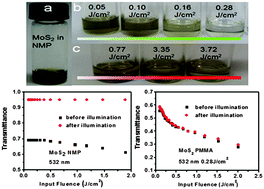Effect of laser illumination on the morphology and optical property of few-layer MoS2 nanosheet in NMP and PMMA
Abstract
Two-dimensional (2D) materials and laser interaction is a very important research topic due to the unique properties of 2D materials, making them a promising candidate for high-power applications such as optical limiters and saturable absorbers for mode locking laser generation. In this paper, we have analysed the morphology and optical property changes of few-layer molybdenum disulfide (MoS2) nanosheet in NMP solution under the illumination of a Q-switched laser with operational wavelength of 532 and 1064 nm with respect to various laser energy densities. The experimental results show significant changes caused by the oxidization of MoS2 into molybdenum oxide (MoO3). Due to the stronger absorption in the visible range, the 532 nm wavelength has a stronger oxidization effect than the 1064 nm illumination wavelength. The nonlinear optical absorption properties of MoS2 in liquid NMP and in solid PMMA have been studied by using the z-scan technique and the results are compared. It has been shown experimentally that the nonlinear optical absorption properties of MoS2 in NMP disappeared but without changes in MoS2/PMMA composites after laser illumination. This confirms that MoS2 is much more stable within PMMA for preserving nonlinear absorption properties under high laser density illumination.


 Please wait while we load your content...
Please wait while we load your content...